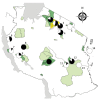Widespread Treponema pallidum Infection in Nonhuman Primates, Tanzania
- PMID: 29774840
- PMCID: PMC6004850
- DOI: 10.3201/eid2406.180037
Widespread Treponema pallidum Infection in Nonhuman Primates, Tanzania
Abstract
We investigated Treponema pallidum infection in 8 nonhuman primate species (289 animals) in Tanzania during 2015-2017. We used a serologic treponemal test to detect antibodies against the bacterium. Infection was further confirmed from tissue samples of skin-ulcerated animals by 3 independent PCRs (polA, tp47, and TP_0619). Our findings indicate that T. pallidum infection is geographically widespread in Tanzania and occurs in several species (olive baboons, yellow baboons, vervet monkeys, and blue monkeys). We found the bacterium at 11 of 14 investigated geographic locations. Anogenital ulceration was the most common clinical manifestation; orofacial lesions also were observed. Molecular data show that nonhuman primates in Tanzania are most likely infected with T. pallidum subsp. pertenue-like strains, which could have implications for human yaws eradication.
Keywords: Africa; One Health; Tanzania; Treponema pallidum; bacteria; eradication; infection; nonhuman primates; spirochetes; yaws.
Figures


References
-
- Harper KN, Fyumagwa RD, Hoare R, Wambura PN, Coppenhaver DH, Sapolsky RM, et al. Treponema pallidum infection in the wild baboons of East Africa: distribution and genetic characterization of the strains responsible. [Erratum in: PLoS One. 2014;9:e92489]. PLoS One. 2012;7:e50882. 10.1371/journal.pone.0050882 - DOI - PMC - PubMed
-
- Wallis J, Lee DR. Primate conservation: the prevention of disease transmission. Int J Primatol. 1999;20:803–26. 10.1023/A:1020879700286 - DOI
Publication types
MeSH terms
LinkOut - more resources
Full Text Sources
Other Literature Sources

